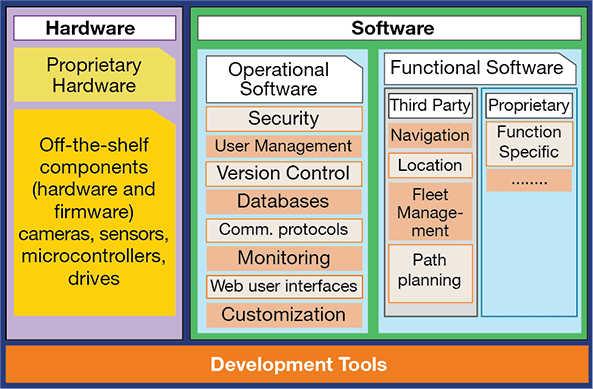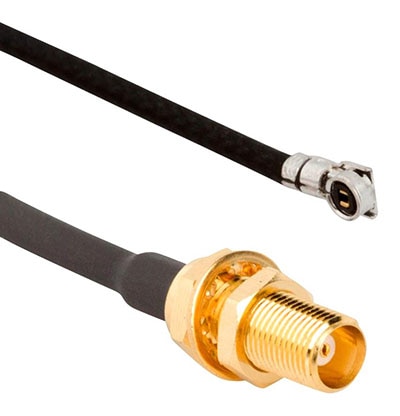Take the Poll | Join our Discussion
sponsored by

Giving intelligence to industrial robots
The growing use of industrial robots has increased worker productivity and safety by automating the most repetitive and dangerous tasks. The range of tasks that industrial robots are able to perform is constantly growing as industrial robots evolve to become more intelligent. Previous generation robots had limited intelligence and autonomy, only capable of performing one or two repetitive tasks. Autonomous mobile robots (AMR) utilize advanced technologies such as artificial intelligence (AI) and machine learning (ML) to navigate through their environment independently, without any external supervision. The expanding skills of these machines enable them to work in industrial terminals, warehouses, homes, and hospitals. This article discusses the types of AMRs, their components, and various connectors used for their operations.
The benefits of using robots in different industries
The adoption of industrial robots plays a significant role in increasing productivity. The advantages of using robots include:
- Reduction of floor space: Robots occupy less space due to their versatile design and advanced programming capabilities.
- Quality Assurance: Robots ensure consistency during the mass production of manufactured products.
- Limiting human work in hazardous environments: Assembly line workers will be safe from accidents caused by human error. High-risk industries like mining and manufacturing, which are prone to disasters, use robots to replace workers in dangerous environments.
- Reduced cost of operation: Significant savings can be achieved in both overhead and direct costs.
- Flexibility: Robots are flexible and can be re-programmed quickly to adapt to new production tasks.
What is an Autonomous Mobile Robot?
An autonomous mobile robot (AMR) is a robot capable of navigating through an uncontrolled environment without the need for physical or electro-mechanical guidance devices.
AMRs use modern techniques like AI and ML to learn new tasks without human intervention or having to create a complex software algorithm (a time consuming process). AMRs are equipped with sensors, such as integrated laser scanners, cameras, and motion detectors, and software for control and perception. Techniques like collision detection help to slow, stop, or steer the robot's path around objects and enable it to continue its task.
Autonomous Mobility is an outstanding feature of AMRs when compared with Collaborative Robots (Cobots). Cobots have fixed robotic arms and are designed to operate safely and intuitively around people. Their use is limited to manufacturers with low-volume or high-mix production. Alternatively, another type of mobile robot called an autonomous guided vehicle (AGV) relies on guidance devices that allow them to travel a predefined navigation route in a relatively controlled space. Table 1 contains the list of differences between AGVs and AMRs.
| Parameters | Automated Guided Vehicles (AGVs) | Autonomous Mobile Robots (AMRs) |
|---|---|---|
| Navigation | Coordinated by magnetic strips or wires installed on or under the floor | Creates or saves a map of the facility and uses it dynamically to calculate the best route between waypoints |
| Deployment | Requires installation of navigation guides | Can be unboxed and put to work within a few minutes |
| Flexibility | Routes are fixed, and to change the operating pattern, redeployment is required | Can be remapped easily, and new destinations can be added |
| Responsiveness | Stops when obstacles are encountered | Senses the obstacles or blocked paths and re-route to find the best path to the destination |
| Cost | Require infrastructural changes to the facility, costing time and lost productivity | Requires no change in the facility, no downtime, and no additional deployment cost |
| Accessibility | Requires expertise to set up or reconfigure the system | Can be set up and reconfigured easily by the workforce on the job |
Table 1: Comparison between AGVs and AMRs
Types of Autonomous Mobile Robots
AMRs are classified into four distinct categories based on their suitability to performing a particular type of action within a warehouse:
Inventory Management AMRs are equipped with cameras that can read and record barcodes during stock replenishment in a warehouse. This type of system is designed to maintain a perfect record of all materials within the facility.
Picking Process AMRs can reduce travel time associated with the picking process and increase productivity of employees. They are further classified as follows:
- Conventional picking AMRs move from one shelf to another, picking products from shelves or racks and placing them on conveyors, carts, or carrying them manually.
- Goods-to-person picking AMRs carry carts with products or items, and move between workers and stations. The workers can pick the item they need from the cart without moving around.
Transportation and Goods-sorting AMRs are beneficial in sorting; for example, they can bring an empty pallet or bin to a workstation where a worker is present. After the product’s barcode is scanned, the AMR takes the product to its destination and drops it off.
Unmanned Aerial Vehicles (UAVs) are lightweight and equipped with RFID-scanning technology do real-time inventory visibility in the warehouse. These UAVs perform automatic inventory checks throughout a warehouse facility.
Outside of industrial and warehousing applications, AMR use is rapidly increasing in home automation and medicine, where they are used for the following purposes:
- Sanitization: Vacuum cleaning, floor cleaning, and disinfection of clinics, hospitals, bathrooms, and nursing homes.
- Caregiving: Assisting caregiving staff in medicine delivery, body fluid sample collection, diagnostic, and health monitoring of patients.
- Gardening: AMR-based lawn mowers can independently cut grass in specified garden areas without human intervention.
The architecture and components of Autonomous Mobile Robots
The architecture of AMRs includes both software and hardware components, as displayed in Figure 1. An AMR’s specific application dictates the customization needs of these hardware and software components.

Figure 1: Architecture of an Autonomous Mobile Robot
Source: Robotics & Automation News
Hardware Components
A typical AMR has several integrated physical components.
- Manipulators: The main body of the robot, consisting of joints, links, and other structural elements
- End Effector: The component that is connected to the last joint of the manipulator, typically used to maneuver objects and perform various tasks
- Batteries: AMRs are powered by Nickel Metal Hydride, Lithium-ion, or Lithium Polymer-based batteries. Battery selection is dependent on factors such as sensor power consumption, actuators, and communication devices.
- Sensors: Intelligent sensors, integrated with software algorithms, allow an AMR to detect and avoid collision with objects, understand and navigate the environment, and provide location information. Commonly used sensors are laser and LIDAR, radar, sonar, infrared, proximity, and cameras.
- Actuators: The driver that converts the output from the controller into physical motion. Typical examples are electric motors, stepper motors, jackscrews, and electric muscular stimulators.
- Cables and connectors: A variety of cables and connectors are used in robotics to deliver power and signal to different parts of the robot to perform their functions.
Software Components
Software components for AMRs consist of functional and operational software.
Functional software: Functional software comprises the software necessary to control the motors, sensors, and various other components required by the AMR. This includes the scanning and visual processing that enables location-awareness and object detection in the robot. The software components also handle navigation. Functional software must regularly receive security and other updates.
Operational software: Fleet management or fleet-navigation applications require operational software for communication and decision-making capabilities, and to interface with external devices such as safety cages, doors, and elevators. Software such as deployment tools for a specific site, monitoring tools, and software version control are also considered operational software.
AMRs use AI techniques such as computer vision and ML to navigate autonomously in a dynamic and unpredictable environment. This autonomy is in stark contrast to AGVs, for which a majority of situations and tasks are predictable and solvable by predefined decision rules.
AMRs use AI techniques such as computer vision and ML to navigate autonomously in a dynamic and unpredictable environment. This autonomy is in stark contrast to AGVs, for which a majority of situations and tasks are predictable and solvable by predefined decision rules.
Amphenol RF Interconnects
Amphenol RF offers various RF coaxial connectors, adapters and cable assemblies that enable key components such as cameras, sensors, and antennas. The versatility of these interconnects allows for substantial crossover and the ability to provide optimal solutions for AMRs.
Figure 2 depicts Amphenol RF’s ultraminiature low-profile PCB connectors (AMC, AMC4, and AMMC), which feature very small footprints (2mm-3mm). The popular snap-on coupling mechanism of these connectors provides easy and secure mating. They offer stable performance in a frequency range of DC-6 GHz, and operate at an impedance of 50 Ω. These connectors are ideal for space-sensitive applications, such as Autonomous Mobile Robots, IoT infrastructure, and consumer devices.

Figure 2: Amphenol RF Ultraminiature Connectors
Buy Now
AMRs also use the Amphenol RF AUTOMATE® Mini-FAKRA connector series, shown in Figure 3. Designed for the next generation of vehicle and autonomous vehicle applications, the AUTOMATE® series supports up to 20 Gbps data transmission. AUTOMATE® Mini-FAKRA connectors reduce almost 80% of installation space requirements compared to traditional FAKRA products. This series of connectors is well-suited for automotive applications such as autonomous vehicles, Advanced Driver Assistance Systems (ADAS), and 360-degree surround-view cameras.

Figure 3: The AUTOMATE® Mini-FAKRA connector series
Buy Now
Summing up: Autonomous Mobile Robots
The need for increased flexibility has accelerated AMR development, both in navigational ability and service capabilities. Future AMRs will use advanced technologies to communicate larger chunks of data across vehicles. The continued adoption of AI, cloud computing, and 5G network architecture will allow AMRs to perceive their environment and make decisions in real-time. Amphenol RF offers a variety of interconnects that allow for substantial crossover and the ability to provide optimal solutions for warehouse robotics.
